As the warmth of the summer nights slowly fades into the arrival of cool winter evenings it can make a few anglers question their motivation for those early morning or night time missions.
Every year as winter approaches I get excited thinking of the many late nights I will spend in the cover of darkness searching for fish. Suiting up in fleece-lined jackets with long tracksuits, beanies, buffs and gloves may seem a bit excessive, but when the temperature drops to single digits and the wind chill factor sets in you won’t be left thinking of retreating to a nice warm bed.
The best thing about this style of fishing is that many locations around Brisbane can be accessed easily by foot or boat. As the summer rains decrease, the water clarity improves and pushes further into the river systems to bring on some great fishing. Over the duration of winter I generally cover waterways ranging from the Sunshine Coast to the Gold Coast targeting species like mulloway, threadfin salmon, tailor, tarpon, dusky flathead and bream.
Thinking outside of the box will open up plenty of opportunities, as many locations that may be too shallow or see heavy boat traffic during the day can turn into a hive of activity at night. Fish take advantage of the lull in boat traffic and the cover of darkness and move in to feast on baitfish holding in these areas.
One of the biggest attractions to any night time lure fisher will be artificial light; lights attract baitfish and prawns, which are easy pickings for predators. There is no doubt Google Earth has given fishers a great advantage when it comes to researching new water and finding structure to fish. From a home computer or smartphone Google Earth can be accessed with the click of a button.
Studying a river beforehand means you can get a general idea of the structure and are able to generate a game plan. Find boat ramps and a location to start, and then find others to fish as the tide moves into a system, similar to a ‘run-and-gun’ approach.
Land-based fishing can be a rewarding experience when quality fish are landed from the bank. Most of the structure that can be fished by a boat can still be accessed by land-based anglers.
This style of fishing normally means packing light. Have a backpack with a tackle tray loaded with lures like shallow running hardbodies, surface lures, vibes and soft plastics with appropriate jigheads, a couple of spools of leader and a quality pair of scissors and pliers. A pair of lip grippers can be a handy tool to assist in landing a fish solo. It’s also a good idea to carry an LED headlamp or torch and a can of insect repellent.
Walking the banks I will only take one combo. A 2500-4000 size spin reel on a suited rod will cover most of the situations you will encounter and deliver a long cast when needed. A pair of old sneakers are a perfect and comfortable footwear solution as some locations may have mud and slippery rocks, or you might be wading knee deep into water. It pays to play it safe and think about that next step when fishing around areas like this.
When arriving at a spot, land-based or in a boat, it can be beneficial to study the area for a few minutes before making a cast. Take notice of the structure, tide flow and direction and any eddies may be created. Also keep a sharp eye out for any baitfish and predators like pelicans.
Each spot may differ with what techniques or lures work best. It can take multiple sessions before you produce a fish. Keep persisting as it can be extremely rewarding to work out a location after putting a lot of research and time into it.
The boat approach covers ground and opens up a lot of opportunities to fish a number of locations. Exploring canal systems and the numerous bridges and deep holes throughout South East Queensland rivers can unlock some great night time fishing.
When boating at night always make sure your boat has the required safety gear and navigation lighting before you head out. I really enjoy fishing at night from the boat, as there is considerably less boat traffic present on the waterways. Finding a ramp close to your destination means a shorter boat ride in those cold temperatures.
Another advantage of boat fishing is having the ability to carry multiple rods on board rigged with different lures and line classes. The Brisbane River has been a popular draw card for many anglers and is loaded with suitable structure for both day and night fishing. The Port of Brisbane is a busy, high-traffic hub that runs 24/7 all year round and still produces some great fishing.
Sounding around the ledges and drop-offs at the mouth and around the wharves and rock walls to locate fish is the norm for fishing the river.
Once fish are located, try dropping down 20g soft vibes or 3/8-1/2oz metal vibes. Work these with slow hops along the bottom. Making sure to keep in contact with your lure to feel the take is important. Large paddle-tail or prawn style plastics covered in some extra scent are commonly used to target threadfin, snapper and mulloway. Remember to keep in mind the exclusion zones when fishing the Port of Brisbane.
The Gold Coast is home to vast canal systems that stem from the Coomera River right down to the Nerang River. It’s an absolute haven for lure fishos providing everything from natural structure to artificial rock walls, pontoons, bridges and marinas. These hold fish throughout the day and can be fished successfully during the night by adapting your approach and technique slightly.
Structure is a key factor to locating fish. Great places to start at night are bridges and the entrances to canals. Bridges house multiple species from the silver ghost of the estuary (mulloway) to threadfin salmon, mangrove jack, flathead, estuary cod, tailor, tarpon and yellowfin bream, depending on the location.
Using a sounder with side imaging can show you in great detail on what is happening below the waterline. Sound around the pylons and drop-offs looking for fish and baitfish. Once located, spot locking with an electric motor or drifting while vertical jigging with a vibration lure or large paddle-tail soft plastic is a proven successful method.
Other species like tailor, tarpon and trevally regularly ambush the baitfish that gather around bridge pylons at night taking shelter in the eddies.
Pay close attention to any surface movement or feeding fish. Casting small hardbodies, plastics or surface lures can provide great sportfishing fun on these species. Setting hooks into a tarpon and having it spend more time in the air than in the water can be a challenge to keep the hooks set.
Another method is to focus on the entrance to canals and the surrounding rock walls and pontoons. As the tide moves through these systems, larger fish hold around this structure and ambush any stray baitfish making their exit. Working plastics in the 3-4” range or casting hardbodies in different diving depths along the rock walls, pontoons and moored boats is a great way to encounter species like trevally, mulloway and cod.
Last year’s winter night fishing provided some great sessions in our local waterways. Putting the time into various locations saw some great winter fishing with mulloway eating shallow crankbaits and angry tailor chasing down surface lures. In one session, my mate Josh and I landed over 20 flathead and two mulloway in four hours of fishing.
Grab a hoodie, rig the rods and set out for a night time adventure in our South East Queensland waterways. You just may be surprised at what is on offer.
Reads: 5601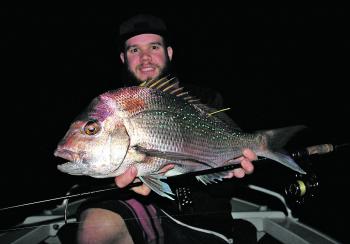
Snapper are a welcome by-catch when chasing mulloway at night.

A great threadfin taken on a soft vibe from the Port of Brisbane.
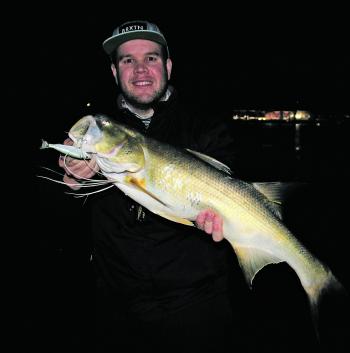
This thready was caught while fishing land-based with a swimbait. It was tagged and released.
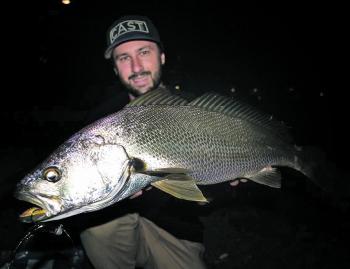
Josh King caught this mulloway land-based fishing with plastics.

A big bream taken on a soft plastic lure.
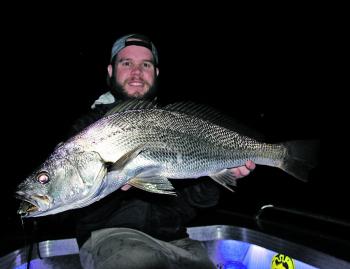
It’s all smiles when one of these silver ghosts is boated.
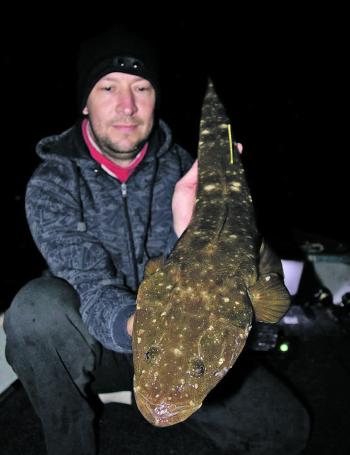
Mark Masters with a flathead which he caught working a canal rockwall.




